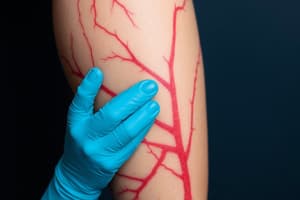Podcast
Questions and Answers
What type of syncope is triggered by neck stimulation, such as turning the head?
What type of syncope is triggered by neck stimulation, such as turning the head?
- Orthostatic syncope
- Vasovagal syncope
- Carotid sinus syncope (correct)
- Psychogenic syncope
Which of the following drug types is known to induce syncope?
Which of the following drug types is known to induce syncope?
- Antidepressants
- Alpha blockers (correct)
- Antibiotics
- NSAIDs
In the evaluation of syncope, which of the following symptoms is crucial for differentiating syncope from a seizure?
In the evaluation of syncope, which of the following symptoms is crucial for differentiating syncope from a seizure?
- Fatigue
- Nausea
- Tongue biting (correct)
- Palpitations
What is the appropriate management for a patient identified as high-risk for syncope?
What is the appropriate management for a patient identified as high-risk for syncope?
Which guideline is utilized for the evaluation of pulmonary embolism in relation to syncope symptoms?
Which guideline is utilized for the evaluation of pulmonary embolism in relation to syncope symptoms?
What best describes the nature of syncope?
What best describes the nature of syncope?
Which of the following is a distinguishing feature between syncope and a seizure?
Which of the following is a distinguishing feature between syncope and a seizure?
Which of these symptoms is considered a red flag in syncope evaluation?
Which of these symptoms is considered a red flag in syncope evaluation?
What should be done if the PERC score is negative in the evaluation for pulmonary embolism?
What should be done if the PERC score is negative in the evaluation for pulmonary embolism?
What characterizes vasovagal syncope?
What characterizes vasovagal syncope?
Flashcards
What is syncope?
What is syncope?
A sudden, brief loss of consciousness caused by a lack of blood flow to the brain. It's usually harmless and resolves quickly on its own.
What is neurally mediated syncope?
What is neurally mediated syncope?
A condition that causes syncope by disruptions in the body's autonomic nervous system. It typically involves a rapid drop in blood pressure, leading to decreased blood flow to the brain.
What is vasovagal syncope?
What is vasovagal syncope?
The most common type of neurally mediated syncope, often triggered by emotional stress, heat, or prolonged standing. It's characterized by symptoms like sweating, nausea, and warmth.
What is situational syncope?
What is situational syncope?
Signup and view all the flashcards
How are syncope and seizures differentiated?
How are syncope and seizures differentiated?
Signup and view all the flashcards
Carotid Sinus Syncope
Carotid Sinus Syncope
Signup and view all the flashcards
Orthostasis
Orthostasis
Signup and view all the flashcards
Syncope vs Seizure Differentiation
Syncope vs Seizure Differentiation
Signup and view all the flashcards
Syncope Decision Tree Approach
Syncope Decision Tree Approach
Signup and view all the flashcards
PERC for Syncope Evaluation
PERC for Syncope Evaluation
Signup and view all the flashcards
Study Notes
Syncope Evaluation
- Syncope is a temporary loss of consciousness due to insufficient blood flow to the brain.
- It's characterized by sudden onset, short duration, and spontaneous recovery.
- Syncope has various causes and requires careful evaluation.
- The provided document details a decision tree for evaluating syncope.
Key Features of the Decision Tree
- Red Flags: Chest pain, palpitations, exertional syncope, family history of sudden cardiac death, abnormal ECG, history of heart disease, indicate a higher risk of a serious cardiac cause.
- Syncope vs. Seizure Differentiation: Distinguishing syncope from seizures is crucial. Syncope involves rapid recovery and prodromal symptoms (e.g., sweating, nausea), while seizures feature postictal confusion, tongue biting, and prolonged confusion.
- High-Risk Diagnoses to Rule Out: The decision tree highlights the need to rule-out serious conditions like abdominal aortic aneurysm (AAA), ectopic pregnancy, subarachnoid hemorrhage, and pulmonary embolism (PE).
Neurally Mediated Syncope
- Vasovagal Syncope: Commonly known as a "faint," characterized by the "3 Ps": posture (standing), prodrome (sweating, nausea, warmth), precipitating trigger (emotional stress, hot environments).
- Situational Syncope: Triggered by specific activities involving bodily function changes, such as defecation, swallowing, urination, or coughing.
- Carotid Sinus Syncope: Occurs with neck stimulation (e.g., turning the head or wearing tight collars).
Disposition Recommendations
- High-risk cases require urgent care or hospitalization.
- Low-risk cases warrant reassurance and outpatient follow-up.
Additional Information
- Pulmonary Embolism (PE) Evaluation: The PERC (Pulmonary Embolism Rule-Out Criteria) score, along with the Wells score, helps assess the probability of PE before ordering a D-dimer test. If PERC is negative, additional testing might be unnecessary.
- Evaluation Framework: Factors like orthostatic intolerance (caused by medications, underlying medical conditions like diabetes, polyneuropathy, and Parkinson's disease) are considered.
Studying That Suits You
Use AI to generate personalized quizzes and flashcards to suit your learning preferences.
Related Documents
Description
Explore the complexities of syncope with this evaluation quiz. Understand the decision tree that leads to differentiating syncope from seizures and identifying red flags that may indicate serious cardiac conditions. Assess your knowledge on high-risk diagnoses to rule out and enhance your diagnostic skills.




